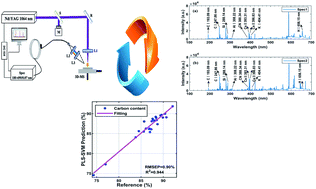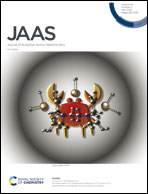The high-accuracy prediction of carbon content in semi-coke by laser-induced breakdown spectroscopy†
Abstract
Semi-coke, as a kind of special coal resource with a relatively high concentration of carbon and low volatility, plays an important role in the coal chemical industry and in creating clean cities. Laser-induced breakdown spectroscopy (LIBS) has been proved to be an effective way to conduct online analysis of coal products. However, the lower volatility of semi-coke makes it hard to press into a slice to obtain a smooth surface for uniform laser-irradiation. Therefore, it is necessary to find an effective way to realize high-accuracy LIBS detection for semi-coke applications. Herein, two feasible methods of sample preparation are attempted, one easy way involves directly painting semi-coke powder onto tape that is suitable for online fast monitoring, and the other more complicated way is to mix a binder into the semi-coke powder so that uniform and tight coal slices are obtained, to improve the repeatability of the measurements. Moreover, a totally new algorithm, a support vector machine (SVM) combined with partial least square (PLS) regression (SVM-PLS), was utilized to establish an effective prediction model to give a high predictive accuracy. The coefficient of determination (R2), root mean square error of prediction (RMSEP), and average relative error (ARE) are 0.944, 0.90%, and 0.80%, respectively. In comparison with the results from the traditional PLS model, SVM residual correction greatly improves the quality of the calibration curve and the RMSEP and ARE values are reduced to 0.17%, thus improving the prediction accuracy, which is much better than the basic PLS regression. Meanwhile, the prediction error from the binder mixed semi-coke slice is significantly reduced compared to that of the directly painted samples on tape. The maximum relative errors (MREs) are 2.71% and 5.19%, and the average RSD values of the characteristic peaks are 12.1% and 16.2%, respectively, indicating that the easy way of painting a sample on tape has some prediction uncertainties. Finally, in a three-day random test, the average RMSEP was found to be 1.89% and the average ARE was 1.74%, which also proves that the binder additive can effectively reduce the matrix effect and enhance the stability of the spectrum for semi-coke measurements. The results indicate that appropriate LIBS analysis on semi-coke is a feasible and promising approach for online predictions using this kind of coal sample.



 Please wait while we load your content...
Please wait while we load your content...